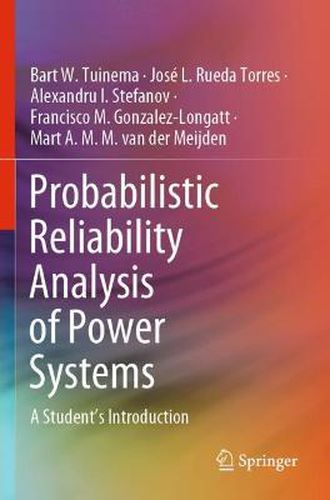Readings Newsletter
Become a Readings Member to make your shopping experience even easier.
Sign in or sign up for free!
You’re not far away from qualifying for FREE standard shipping within Australia
You’ve qualified for FREE standard shipping within Australia
The cart is loading…






This title is printed to order. This book may have been self-published. If so, we cannot guarantee the quality of the content. In the main most books will have gone through the editing process however some may not. We therefore suggest that you be aware of this before ordering this book. If in doubt check either the author or publisher’s details as we are unable to accept any returns unless they are faulty. Please contact us if you have any questions.
This textbook provides an introduction to probabilistic reliability analysis of power systems. It discusses a range of probabilistic methods used in reliability modelling of power system components, small systems and large systems. It also presents the benefits of probabilistic methods for modelling renewable energy sources. The textbook describes real-life studies, discussing practical examples and providing interesting problems, teaching students the methods in a thorough and hands-on way.
The textbook has chapters dedicated to reliability models for components (reliability functions, component life cycle, two-state Markov model, stress-strength model), small systems (reliability networks, Markov models, fault/event tree analysis) and large systems (generation adequacy, state enumeration, Monte-Carlo simulation). Moreover, it contains chapters about probabilistic optimal power flow, the reliability of underground cables and cyber-physical power systems.
After reading this book, engineering students will be able to apply various methods to model the reliability of power system components, smaller and larger systems. The textbook will be accessible to power engineering students, as well as students from mathematics, computer science, physics, mechanical engineering, policy & management, and will allow them to apply reliability analysis methods to their own areas of expertise.
$9.00 standard shipping within Australia
FREE standard shipping within Australia for orders over $100.00
Express & International shipping calculated at checkout
This title is printed to order. This book may have been self-published. If so, we cannot guarantee the quality of the content. In the main most books will have gone through the editing process however some may not. We therefore suggest that you be aware of this before ordering this book. If in doubt check either the author or publisher’s details as we are unable to accept any returns unless they are faulty. Please contact us if you have any questions.
This textbook provides an introduction to probabilistic reliability analysis of power systems. It discusses a range of probabilistic methods used in reliability modelling of power system components, small systems and large systems. It also presents the benefits of probabilistic methods for modelling renewable energy sources. The textbook describes real-life studies, discussing practical examples and providing interesting problems, teaching students the methods in a thorough and hands-on way.
The textbook has chapters dedicated to reliability models for components (reliability functions, component life cycle, two-state Markov model, stress-strength model), small systems (reliability networks, Markov models, fault/event tree analysis) and large systems (generation adequacy, state enumeration, Monte-Carlo simulation). Moreover, it contains chapters about probabilistic optimal power flow, the reliability of underground cables and cyber-physical power systems.
After reading this book, engineering students will be able to apply various methods to model the reliability of power system components, smaller and larger systems. The textbook will be accessible to power engineering students, as well as students from mathematics, computer science, physics, mechanical engineering, policy & management, and will allow them to apply reliability analysis methods to their own areas of expertise.